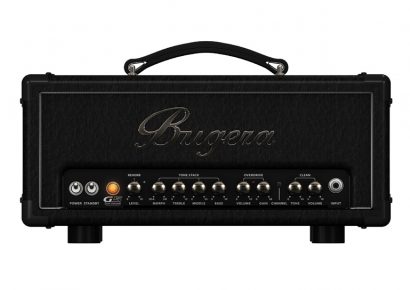Compared to the original amPlug range, the amPlug 2 line has been redesigned with a more authentic-looking, left-justified Vox logo and a swivel jack which is better able to plug into a variety of guitars with unique jacks including Fender Stratocasters and Ibanez Jems/Universes, which could be a little squeezy with the old system. Each unit features three little thumbwheels: on the guitar models these control volume, tone and gain. There’s also an effect button which scrolls between three different effect presets — in each case there are three modulation, three delay and three reverb presets. There’s also an auxiliary input and a headphone output. In the case of the bass model there are controls for volume and tone, while the third knob is the level control for nine inbuilt rhythm tracks to jam along with: hold down the little button on that one while scrolling the wheel and you can adjust the tempo of the track. Very clever.
AC30
This amPlug does a great job of capturing the essence of the classic Vox AC30tone in a bite-size form. It’s probably not going to fool Brian May or Jimmy Page, but it sounds great on its own merits with a good range of tones from ringing cleans to big fat overdrives. The modulation feels a bit synthetic, but the delay and reverb settings are really handy, especially since this kind of right-in-your-ear sound really benefits from a little ambience.
CLASSIC ROCK
Designed to recall classic British 100 watt stacks (you know the ones I mean), the Classic Rock amPlug actually has a bit more gain than you might expect of a purely classic rock tone. It’ll take you all the way into 80s hard rock territory and its mid-boost mode is great for soloing. The modulation seems like a better fit here than on the AC30 version, and again there’s a great range of gain. You could cover all of Van Halen’s ‘Hot For Teacher’ with this bad boy.
METAL
The Metal amPlug nails the extended low end and compressed gain structure required of metal, but it’s also surprisingly good for semi-clean tones of the blues-rock variety, especially if you use humbuckers. But its real reason to live is to crank out ridiculous amounts of gain, and it does that very well. I hit it with high-powered humbuckers and it didn’t break a sweat. It’s very handy for those atmospheric Slayer ‘spooky section’ clean tones as well as more modern metalcore rhythm crunch.
BASS
The bass model is a little more restrained in its sound-sculpting abilities since it has no way to adjust the gain: you’re pretty much stuck with a clean sound and a tone control. The tone control has plenty of usable range to dial in everything from a deep round sound to a sharp Megadethian clang, and the nine rhythm tracks cover all sorts of grooves. In that sense it becomes even handier than the guitar amPlugs: it feels like you’re actively doing something for your playing rather than jamming out for fun.
These are all handy little units and they all cover a surprising amount of territory for something so small. The fact that they all use all-analog circuits will appeal to a lot of players who are turned off by the idea of digital modelling units and modelling apps: everything you hear is generated the old-fashioned way, and responds accordingly.

